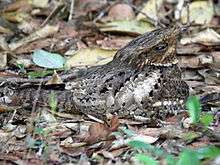Chuck-will's-widow
| Chuck-will's-widow | |
|---|---|
 | |
| Female | |
| Scientific classification | |
| Kingdom: | Animalia |
| Phylum: | Chordata |
| Class: | Aves |
| Subclass: | Neornithes |
| Infraclass: | Neognathae |
| (unranked): | Cypselomorphae |
| Order: | Caprimulgiformes |
| Family: | Caprimulgidae |
| Subfamily: | Caprimulginae |
| Genus: | Antrostomus |
| Species: | A. carolinensis |
| Binomial name | |
| Antrostomus carolinensis Gmelin, 1789 | |
| Synonyms | |
|
Caprimulgus carolinensis | |
The chuck-will's-widow (Antrostomus carolinensis) is a nocturnal bird of the nightjar family Caprimulgidae. It is found in the southeastern United States near swamps, rocky uplands, and pine woods. It migrates to the West Indies, Central America, and northwestern South America. This bird is generally confused with the better-known whippoorwill (Antrostomus vociferus),[2] due to their similar calls and unusual names. Though rather closely related, they are two distinct species.
 |
Song of the chuck-will's-widow (in background)
|
| Problems playing this file? See media help. | |
A fairly typical nightjar, it has a short bill and a long tail typical of the family. This species has mottled brownish underparts, a buff throat, reddish-brown feathers lined with black, and brown and white patterning on head and chest, differing from the gray and black of its more common cousin. Males have patches of white on their outer tail feathers. It is the largest nightjar in North America. In length, it ranges from 28 to 33 cm (11 to 13 in). The wingspan can range from 58 to 66 cm (23 to 26 in). The body mass of the species is from 66 to 188 g (2.3 to 6.6 oz).[3] Among standard measurements, the wing chord is 20.1 to 22.5 cm (7.9 to 8.9 in), the tail is 13 to 15.1 cm (5.1 to 5.9 in), the bill is 1.1 to 1.4 cm (0.43 to 0.55 in) and the tarsus is 1.5 to 1.9 cm (0.59 to 0.75 in).[4]
Its common name derives from its continuous, repetitive song that is often heard at night. This consist of a series of calls with a vibrating middle note between two shorter notes, not much shifting in pitch. It is slower, lower-pitched and less piercing than the song of the whip-poor-will. "Chuckwuts-widow" is another common name less often found, but also imitating the rhythm of the bird's calls. Other alternative names include "Chip-fell-out-of-a-oak".[5]
It eats primarily insects, particular those active at night such as moths, beetles, and winged ants. It will also eat small birds and bats, swallowing them whole.[6][7]
Females do not build nests, but rather lay eggs on patches of dead leaves on the ground. The eggs, which are pink with spots of brown and lavender, are subsequently incubated by the female.
Gallery
 Eggs on nest of leaves
Eggs on nest of leaves Camouflaged female on nest
Camouflaged female on nest Pretending to be hurt
Pretending to be hurt Perched on low, open branch
Perched on low, open branch Perched on low, open branch
Perched on low, open branch Adult male (upper right) and female (lower left)
Adult male (upper right) and female (lower left)
Footnotes
- ↑ BirdLife International (2012). "Caprimulgus carolinensis". IUCN Red List of Threatened Species. Version 2012.2. International Union for Conservation of Nature. Retrieved 29 October 2012.
- ↑ For example, Henninger (1906) combines the old scientific name of C. carolinensis with the common name "Whip-poor-will". As C. carolinensis does not occur in the area discussed, he obviously refers to C. vociferus. In other cases, the specific identity of birds may not be determinable.
- ↑ Chuck Wills Widow. All About Birds. The Cornell Lab of Ornithology.
- ↑ Holyoak, D.T. (2001): Nightjars and their Allies: the Caprimulgiformes. Oxford University Press, Oxford, New York. ISBN 0-19-854987-3.
- ↑ Cleere, Nigel (2010). "Appendix 2 – Alternative English Names". Nightjars, Potoos, Frogmouths, Oilbird and Owlet-nightjars of the World. Old Basing: WILDGuides. pp. 443–447. ISBN 978-1-903657-07-2.
- ↑ Owre, Oscar (September 1967). "Predation by the Chuck-will's-widow upon migrating warblers" (PDF). Wilson Bulletin. 79 (3): 342.
- ↑ Thayer, Gerald H (1899). "The Chuck-will's-widow on Shipboard" (PDF). The Auk. 16 (3): 273–276. doi:10.2307/4069463.
References
- Henninger, W.F. (1906). "A preliminary list of the birds of Seneca County, Ohio" (PDF). Wilson Bulletin. 18 (2): 47–60.
- Stager, Kenneth E. (2007): Chuck-Will's-Widow. In: Encyclopedia Americana.
External links
| Wikimedia Commons has media related to Caprimulgus carolinensis. |
| Wikispecies has information related to: Caprimulgus carolinensis |
- audubon.org
- Chuck-will's-widow – USGS Patuxent Bird Identification InfoCenter
- Chuck-will's-widow Species Account – Cornell Lab of Ornithology
- Chuck-will's-widow Bird Sound
